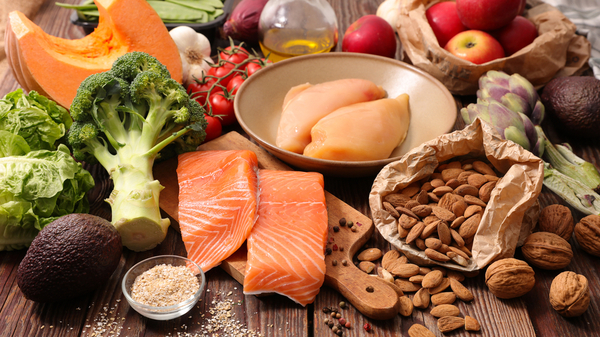By Katherine Watt
Intermittent fasting (IF) was the most Googled diet in 2019. It’s basically an eating pattern that involves a regular cycle of fasting and eating, with varying lengths of time for the fasting section.
But fasting in itself is not new; it’s been around since the dawn of civilization, with early humans often forced to go for days without food until they successfully hunted something to eat or found something to pick. It’s also been widely practised for religious reasons for thousands of years.
Fasting for a fixed period of time, however, is a more recent phenomenon, thanks in part to recent studies showing the numerous health benefits: better blood sugar control, improving heart health, decreasing blood pressure, and, most recently, being good for brain function (as shown in animal studies).
Reset your immune system
Intermittent fasting can also help reset your immune system, as well as giving your gut a break and a chance to recover from digestion, which takes up a lot of energy. Last, and by no means least, it’s an effective way to lose weight by both limiting calorie intake and boosting metabolism.
Dr Michael Mosley, TV journalist and author, was one of the first to make intermittent fasting popular in 2012 with his 5:2 diet and book The Fast Diet, co-written with Mimi Spencer.
Blood sugar problems
He and his wife, Dr Clare Bailey, also a GP, have both learned firsthand the benefits of intermittent fasting. ‘It was 2012, and I went to my GP for a skin problem. She did a blood test and told me my blood sugar was in the diabetic range and recommended medication,’ explains Dr Mosley.
‘It was a huge shock. I was 5 foot 11 inches tall and weighed about 90kg, so my BMI was over the healthy range. My dad had died of Type 2 diabetes so I was determined to try and reverse it.’
Dr Mosley began researching the health benefits of intermittent fasting and came across lots of different types. He tried a number of them before coming up with the 5:2 diet. This involved eating normally for five days of the week, and then for the other two days consuming just 600 calories. ‘The 5:2 diet is great for losing weight quickly. It can do good things for your brain as well as improving blood sugars and reducing diabetes,’ he says.
9kg weight loss
By following his 5:2 diet, Dr Mosley lost 9kg within a couple of months, shed three inches from his waist and reversed his diabetes diagnoses, so his blood sugar levels went back to normal. Seven years later he still weighs a healthy 78kg and his blood sugar levels remain normal.
More recently Dr Mosley has written The Fast 800 (£8.99, Short Books), which is based on latest research into intermittent fasting as well as a different form of IF: “time-restricted eating”. This is where you restrict your meals to a specific eating window during the day. It’s often referred to as 16:8, the idea being that you fast for 16 hours and then you have an eight-hour window during which you can eat.
‘The Fast 800 really took off as people realised the huge benefits of fasting,’ says Dr Mosley. But these days, he advocates an easier version of the system: the 14:10, working on a similar premise but with a shorter fasting period.
The Fast 800
He’s also launched an online lifestyle programme, The Fast 800 (thefast800.com), while Dr Bailey wrote companion title, The Fast 800 Recipe Book (Short Books, £16.99).
This project is a rapid weight-loss programme that takes a three-pronged approach. First you eat only 800 calories a day for a few weeks, next switching to a 5:2 pattern with 800 calories on just two days of the week, making sure all meals on regular days and restricted days are made up of foods that are part of a Mediterranean-style diet.
These would include fish, nuts, olive oil, non-starchy fruit and veg. He also advises reducing red meat, saturated animal fat and refined sugar.
Time-restricted eating
Finally, he recommends time-restricted eating whereby you extend your natural overnight fast by several hours, which is easily achieved by having dinner earlier or breakfast later. ‘Start by having a go at 12 hours for your overnight fast and then try 14,’ he suggests.
‘While 16:8 may be a popular fasting method, I think for most people, 14:10 is more sustainable. There are recent studies that have shown people find it easier to follow and yet you still get the same metabolic and weight-loss advantages,’ he says.
How to do 14:10
Introduce yourself to intermittent fasting the gentle way with 14:10. Here are some helpful pointers:
Start with 12:12, whereby you go for 12-hours overnight with no food, then have a 12-hour window for eating.
Next, gradually move your evening meal earlier and earlier than usual, and your breakfast later. You’ll find you will eventually be able to drop breakfast and make the fasting window at least 14 hours.
Drink an extra litre of water a day when fasting, because as you burn fat you release water. Headaches or light-headedness are often due to dehydration. If you’re not sure you’re drinking enough, check the colour of your urine: clear, pale or yellow is good. Dark yellow means you need more fluid.
Your fluid allocation includes herbal teas, black tea and coffee. Any milk added will break your fast so save it for the eating window.
Make sure you eat enough protein, fibre and essential nutrients. Aim for a minimum of 50g of protein a day. Follow a lower-carb diet rich in fish, nuts, olive oil, fresh fruit and salad veg, and low in red meat, refined sugar and saturated fat.
You can have shakes to replace some meals during days of only 800 calories or so. These should be low in sugar, high in fibre, and contain essential protein, fats, vitamins and minerals. You can find Mediterranean-formula shakes at thefast800.com).
Why it works
Dr Clare Bailey explains why intermittent fasting is so effective and what happens
to your body when you fast.
While she doesn’t need to lose weight, she still follows the principles of the diet, eating plenty of fibre and healthy fats and rarely snacking, so she gets the blood sugar-balancing benefits it offers:
‘Your body is like a hybrid car, which can run on sugar or fat. It prefers burning sugar because it’s easier to access than fat. But after 8-10 hours without sugar when you are fasting, your body will start to burn fat instead. It does this by turning stored fat into ketone bodies, which provide a steady energy supply. This process is called ketosis.
Although some people worry they will run out of energy if they don’t eat on a frequent basis, most of us have enough fat on board to last us four or five months. Time-restricted eating helps your body to switch into ketosis so you’re not starving. Couple this with exercise during the day, and it will help to reduce your appetite and increase weight loss.
Over the past 4-5 years, fasting has helped many thousands of people with type 2 diabetes get their blood sugar level down. Intermittent fasting is not expensive; it’s accessible and easy to combine with a working life and family and it has fast and effective results.
You should, however, always check with your doctor before embarking on any diet or fasting programme, particularly if you have medical conditions or are on medication. While it does help reverse diabetes, eating this way is not for everyone and can bring about such a fast reduction in blood sugar that medication will need to be more closely monitored and adjusted.’
Visit thefast800.com for more information.










